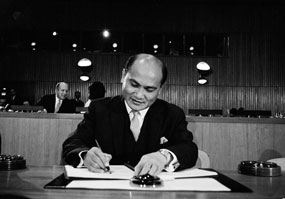|
International Covenant on Economic, Social and Cultural Rights
New York, 16 December 1966
The International Covenant on Economic, Social and Cultural Rights (hereinafter “ICESCR”), together with the International Covenant on Civil and Political Rights (hereinafter “ICCPR”), were adopted by the United Nations General Assembly on 16 December 1966 by consensus, with no abstentions (General Assembly resolution 2200 A (XXI) of 16 December 1966). The ICESCR entered into force in general on 3 January 1976 and the ICCPR on 24 March 1976. Both treaties and the Optional Protocol to ICCPR resulted from some eighteen years of debates and negotiations in the new institutional context provided by the United Nations. Pressures for their adoption have been exerted by the new States issued from the decolonization movement and the Latin American States. The fate of the ICESCR was marked by the perception of Western countries that the human rights it enshrined, the duties it imposed on States and the monitoring mechanisms were essentially different from those provided for in the ICCPR. From an opposite perspective, that was the view of the Eastern countries, too. In fact, the Cold War provided two different political, legal and economic models and each set of rights, civil and political rights (hereinafter “CPR”) and economic, social and cultural rights (hereinafter “ESCR”), was prevalent in each of them. In any case, both Western European States as well as Latin American States ratified both treaties. Legal authorities brought into that already complex picture, elements taken from liberal constitutional law and invoked the doctrine of generations, awarding to ESCR a “second” generation of human rights, mainly programmatic and requiring important allocations of resources for implementation, compared to the “first” generation of CPR, self-executing and with a monitoring system. The stigma of non-binding commitments and the costs of the implementation of ESCR gave flesh and bones to an interpretation of these rights that became an obstacle for their progression. Today, it is clearer than 50 years ago that all human rights require positive obligations from States and that human rights have costs. As early as 1968, the United Nations realized that it was necessary to stress that ESCR were human rights. Accordingly, the Proclamation of Teheran declared that “since human rights and fundamental freedoms are indivisible, the full realization of civil and political rights without the enjoyment of economic, social and cultural rights, is impossible. The achievement of lasting progress in the implementation of human rights is dependent upon sound and effective national and international policies of economic and social development”. Later on, during the World Conference on Human Rights held in Vienna in 1993, the international community stressed again that “[a]ll human rights are universal, indivisible and interdependent and interrelated. The international community must treat human rights globally in a fair and equal manner, on the same footing, and with the same emphasis. While the significance of national and regional particularities and various historical, cultural and religious backgrounds must be borne in mind, it is the duty of States, regardless of their political, economic and cultural systems, to promote and protect all human rights and fundamental freedoms”. In practice, both Covenants bind almost the same constituency, 173 States Parties for the ICCPR and 171 for the ICESCR, as of 18 October 2020. The United States is only bound by the ICCPR while the Russian Federation is party to both Covenants and China only to the ICESCR. Cuba remains out of this scheme. Almost the ninety percent of the members of the State community are bound by the provisions of these two treaties. The ICESCR is structured in five parts. The Preamble and Parts I and V are common with the ICCPR. The Preamble recalls that human rights derive from the inherent dignity of the human person and the obligation of States under the Charter of the United Nations to promote universal respect for, and observance of, human rights and freedoms. Part I, as in the ICCPR, embodies the right of all peoples to self-determination, including the permanent sovereignty over natural resources and the duty of States administering Non-Self Governing and Trust Territories to promote self-determination. By 1960, the political weight of the newly independent States was as important as their main interests: self-determination and non-discrimination. Both Covenants deal with those issues. Part V contains the Final Provisions as does Part VI of the ICCPR. Part II embodies the main principles regarding ESCR and their implementation. Article 2 embodies the obligation of each State Party to take steps, individually and through international assistance and co-operation, especially economic and technical, to the maximum of its available resources, with a view to achieving progressively the full realization of the rights recognized in the Covenant by all appropriate means, including particularly the adoption of legislative measures, without discrimination. The different language of this provision when compared to article 2 of the ICCPR gave room to arguments on the programmatic nature of ESCR to the trend that the implementation of these rights can be delayed sine die, and, accordingly, that these rights are non-justiciable. The idea that the full realization of ESCR could be reached progressively and in the light of the maximum of every State’s available resources, including international assistance and co-operation, gave rise to the argument that lacking resources, no realization could be claimed. Slowly but surely, the discussion about the progressive versus immediate character of the obligations derived from the ICESCR shifted into the understanding that ESCR, like any rights, require the adoption of legal rules and public policies so that individuals can exercise said rights and, if needed, demand their enforcement through legal action. Also, the growing shared understanding that progressivity does not imply the absence of immediate obligations created room for the intervention of courts and tribunals, which exerted a great influence on the content of the obligations imposed on the State in relation to ESCR. General Comment 3 by the Committee on Economic, Social and Cultural Rights (hereinafter “CESCR”) advanced the debate when it stated that the Covenant “imposes an obligation to move as expeditiously and effectively as possible towards that goal [the full realization of the rights in question]”. At the same time, it clarified that some engagements could be immediately satisfied like the principle of non-discrimination. The CESCR elaborated further on States' obligations to respect, to protect and to fulfil. It also pointed out that any deliberately retrogressive measures would require the most careful consideration and would need to be fully justified by reference to the totality of the rights provided for in the Covenant and in the context of the full use of the maximum available resources. Article 3 refers to the equal rights of men and women regarding ESCR. Article 4 provides criteria for the permissible limitation of these rights. It points to limitations as determined by law only in so far as this may be compatible with the nature of these rights and solely for the purpose of promoting the general welfare in a democratic society. These criteria will be complemented by the Limburg Principles on the Implementation of the ICESCR (1987) and the Maastricht Guidelines on Violations of ESCR (1998). Finally, article 5 prevents the misuse of the Covenant prohibiting larger limitations of the protected rights than provided for in the Covenant and the restriction or derogation of human rights not included in the Covenant, mirroring the same provision in the ICCPR. Part III deals with the protected rights: the right to work; the right to the enjoyment of just, and favourable conditions of work; the right to form and join trade unions; the right to social security, including social insurance; the right to the protection of the family; the right to an adequate standard of living; the right to the enjoyment of the highest attainable standard of physical and mental health; the right of everyone to education; and the right to take part in cultural life. Considering both Covenants, only three of the human rights embodied in the Universal Declaration of Human Rights have not found their place in the treaties: the right to seek asylum, the right to a nationality and the right to property. Disagreements, mainly grounded on political reasons, prevented any consensus. Part IV of the ICESCR provides for the submission of periodical reports by States Parties to the ECOSOC regarding the measures which they have adopted, and the progress made in achieving the observance of the protected rights. The Council would transmit the reports to the Commission on Human Rights. As different from ICCPR, the ICESCR does not provide for the establishment of a treaty body. The current Committee on Economic, Social and Cultural Rights is a pretorian creation of the United Nations and its Member States. In 1978, the ECOSOC established a sessional working group on the implementation of the ICESCR (decision 1978/10 of 3 May 1978), which in 1985 was transformed into a Committee on Economic, Social and Cultural Rights, composed by 18 independent experts elected, through secret ballot, from a list proposed by States Parties to the Covenant (resolution 1985/17 of 28 May 1985). The CESCR - as other treaty bodies - is in charge of the examination of periodical reports submitted by State Parties, and to that end, it adopts General Comments on the scope of the protected rights and indicating the areas on which information should be provided. At the same time, the Committee provides treatment to the complaints lodged with it as provided for in the Optional Protocol to the ICESCR adopted on 10 December 2008, which entered into force in general on 5 May 2013 and binds 25 States as of 18 October 2020. It also conducts the inquiry procedure provided for in article 11 of the Optional Protocol to the ICESCR in cases of grave and systematic violation of protected rights. The influence of the ICESCR on legal developments, including treaties and jurisprudence, has been substantive. It elaborated and turned into legal rules the so-called “social rights” on which the International Labour Organization had been working since the end of the First World War, like work, social security, hours of work, work accidents, minimum working age, freedom of association and the right to form and join trade unions, non-discrimination in employment, among others. It also deals with some of the subjects which the World Health Organization and the Food and Agriculture Organization work on. The Covenant became the source of regional rules as those embodied in the Banjul Charter, the African Charter on Human and Peoples Rights (1981), the Pretoria Declaration on Economic, Social and Cultural Rights in Africa (2004) and the Protocol of San Salvador, Additional Protocol to the American Convention on Human Rights in the Area of Economic, Social and Cultural Rights (1988). It also influenced the development of the jurisprudence of the African Commission on Human Rights as well as that of the Inter-American System, especially before the entry into force of the Protocol of San Salvador on 16 November 1999. It also had impact on the constitutional protection of ESCR in African Constitutions and on the jurisprudence of national courts in Latin America. The Covenants reached fifty years, a mature age. We hope they will be illuminating the way forward. This Introductory Note was written in November 2020.
Related Materials
A. Legal Instruments
Universal Declaration of Human Rights, Paris, 10 December 1948. International Covenant on Civil and Political Rights, New York, 16 December 1966, United Nations, Treaty Series, vol. 999, p. 171. Optional Protocol to the International Covenant on Civil and Political Rights, New York, 16 December 1966, United Nations, Treaty Series, vol. 999, p. 171. International Covenant on Economic, Social and Cultural Rights, New York, 16 December 1966, United Nations, Treaty Series, vol. 993, p. 3. Proclamation of Teheran, Teheran, 13 May 1968. Optional Protocol to the International Covenant on Economic, Social and Cultural Rights, New York, 10 December 2008. B. DocumentsGeneral Assembly resolution 217 E (III) of 10 December 1948 (Preparation of a Draft Covenant on Human Rights and Draft Measures of Implementation). General Assembly resolution 543 (VI) of 5 February 1952 (Preparation of two Draft International Covenants on Human Rights). General Assembly resolution 2200 A (XXI) of 16 December 1966 (International Covenant on Economic, Social and Cultural Rights, International Covenant on Civil and Political Rights and Optional Protocol to the International Covenant on Civil and Political Rights). Economic and Social Council decision 1978/10 of 3 May 1978. Economic and Social Council resolution 1985/17 of 28 May 1985. Note verbale dated 5 December 1986 from the Permanent Mission of the Netherlands to the United Nations Office at Geneva addressed to the Centre for Human Rights, Annex “The Limburg Principles on the Implementation of the International Covenant on Economic, Social and Cultural Rights” (E/CN.4/1987/17, 8 January 1987). Maastricht Guidelines on Violations of Economic, Social and Cultural Rights, Maastricht, January 1998. C. DoctrineD. Moeckli & H. Keller with C. Heri (ed.), The Human Rights Covenants at 50: Their Past, Present, and Future, Oxford University Press, Oxford, 2018. E. Riedel, “Committee on Economic Social and Cultural Rights (CESCR)” in Max Planck Encyclopedia on Public International Law, Oxford University Press, 2010. E. Riedel, “International Covenant on Economic, Social and Cultural Rights (1966)” in Max Planck Encyclopedia on Public International Law, Oxford University Press, 2011.
A first draft convention was prepared by the Commission on Human Rights during its sixth session, in 1950, and a report was submitted to the Economic and Social Council for consideration at its sixth session (E/1618 and Corr. 1 and Add. 1). In addition, the Council had before it two reports which the Commission had requested the Secretary-General to prepare (E/1721 and Corr. 1, and E/1732), dealing with federal and colonial clauses, and the possibility for the proposed Human Rights Committee to seek advisory opinions from the International Court of Justice. In resolution 303 I (XI) of 9 August 1950, the Council concluded that further progress could not be made until policy decisions were taken by the General Assembly on certain matters, including the general adequacy of the first draft and the articles relating to its implementation, the desirability of including articles on economic, social and cultural rights, and the desirability of including special articles relating to federal states and to Non-Self-Governing and Trust Territories. The General Assembly considered these topics at its fifth session, and adopted resolution 421 (V) of 4 December 1950 deciding that the covenant should include economic, social and cultural rights as well as a clause with regard to its territorial application, and that the draft articles proposed by the Commission on Human Rights should be revised and additional rights be added. Furthermore the Commission was asked to consider provisions relating to federal states and petitions with regard to alleged violations of the Covenant. The resolution was transmitted to the Commission on Human Rights by the Economic and Social Council by resolution 349 (XII) of 23 February 1951. At its seventh session, in 1951, the Commission on Human Rights, assisted by representatives of the International Labour Organization (ILO), the United Nations Educational, Scientific and Cultural Organization (UNESCO) and the World Health Organization (WHO), completed its draft on economic, social and cultural rights (see report of the Commission, E/1681, and Corr. 1, Corr. 2 (French only), Corr. 3 and Corr. 4 (Spanish only)). The report was submitted to the Economic and Social Council, which discussed the draft articles and measures for its implementation at its session of the same year. In view of the discussions, by resolution 384 (XIII) of 29 August 1951, the Council invited the General Assembly to reconsider its decision to include in one covenant provisions on both economic, social and cultural rights, and civil and political rights. At the sixth session of the General Assembly, in 1951, the question of the Draft Covenant on Human Rights and measures of implementation was discussed at forty meetings of the Third (Social, Humanitarian and Cultural) Committee and subsequently at two plenary meetings of the General Assembly. After continued discussions in plenary, the General Assembly requested, in resolution 543 (VI) of 5 February 1952, contrary to its previous decision, that the Commission on Human Rights draft two separate Covenants, to be submitted simultaneously for consideration by the General Assembly. As further requested by the General Assembly in resolution 549 (VI) of 5 February 1952, the Economic and Social Council held a special session on 24 March 1952, and transmitted the above recommendations to the Commission on Human Rights. The Commission on Human Rights continued its work on the preparation of the two draft covenants at its eighth and ninth sessions, but was not able, in the available time, to carry out the instructions of the General Assembly. At its tenth session, in 1954, it however completed the two draft covenants (see the report of the Commission, E/2573). Without dealing with the substance of the drafts, the Economic and Social Council adopted resolution 545B I (XVII) on 29 July 1954, transmitting the report of the Commission to the General Assembly. At the ninth session of the General Assembly, in 1954, the item was again allocated to the Third Committee which began a first reading of the draft covenants. Preparation of the draft covenants continued in the Third Committee during the tenth to the seventeenth sessions of the General Assembly, from 1955 to 1962. In 1963, the final substantive articles were adopted (see the report of the Third Committee to the General Assembly, A/5655). On 12 December 1963, the General Assembly invited all Governments to consider the text of the articles adopted by the Third Committee and decided to make a special effort to adopt the entire texts, including the final clauses, of the draft covenants at its nineteenth session, the following year (resolution 1960 (XVIII)). Owing to the special circumstances prevailing then, work on the covenants could not however be continued in 1964 and, at the twentieth session, in 1965, the General Assembly decided to defer the topic due to its heavy agenda (resolution 2080 (XX) of 20 December 1965). At the twenty-first session, in 1966, the Third Committee completed the drafting of the covenants, adopting final clauses and articles relating to measures of implementation. The two draft Covenants and the Optional Protocol to the Covenant on Civil and Political Rights were submitted to the General Assembly (see the report of the Third Committee to the General Assembly, A/6564). After discussions in plenary, the General Assembly adopted unanimously the recommendation of the Third Committee in resolution 220 A (XXI) of 16 December 1966, the three instruments being annexed thereto. In separate votes, the General Assembly adopted the Covenant on Economic, Social and Cultural Rights, with a vote of 105 to 0, the Covenant on Civil and Political Rights, with a vote of 106 to 0, and the Optional Protocol to the Covenant on Civil and Political Rights with a vote to 66 to 2, with 38 abstentions. The three instruments were opened for signature on 16 December 1966. In accordance with their respective provisions, the International Covenant on Economic, Social and Cultural Rights entered into force on 3 January 1976 and the International Covenant on Civil and Political Rights, together with its Optional Protocol, entered into force on 23 March 1976. Text of the Covenant Selected preparatory documents Report of the first session of the Drafting Commission of the Commission on Human Rights, held from 9 to 25 June 1947 (E/CN.4.21, 1947) The Covenant entered into force on 3 January 1976. For the current participation status of the Covenant, as well as information and relevant texts of related treaty actions, such as reservations, declarations, objections, denunciations and notifications, see:
|
||||||||||||||||||||||||||||||||||||||||||










